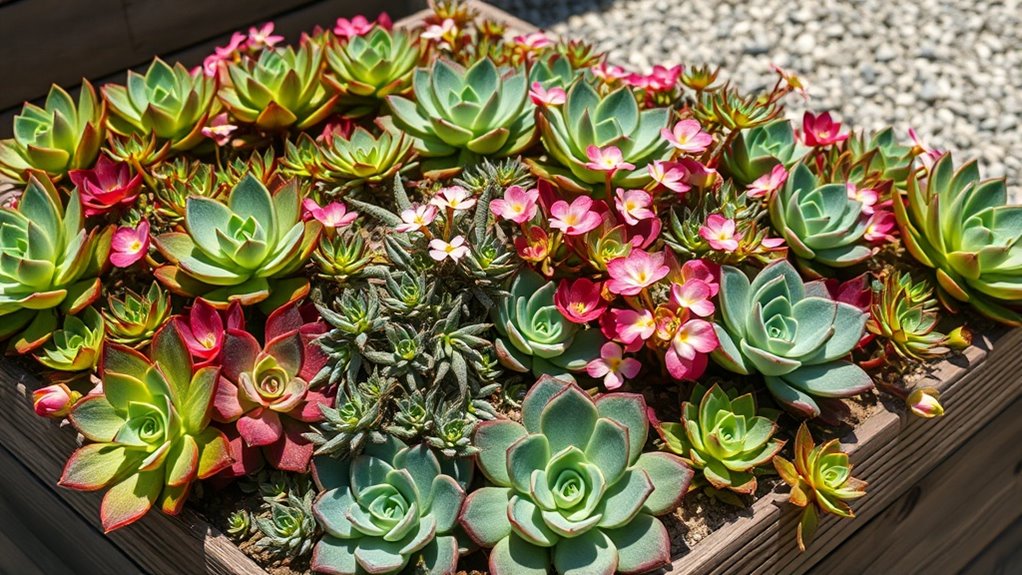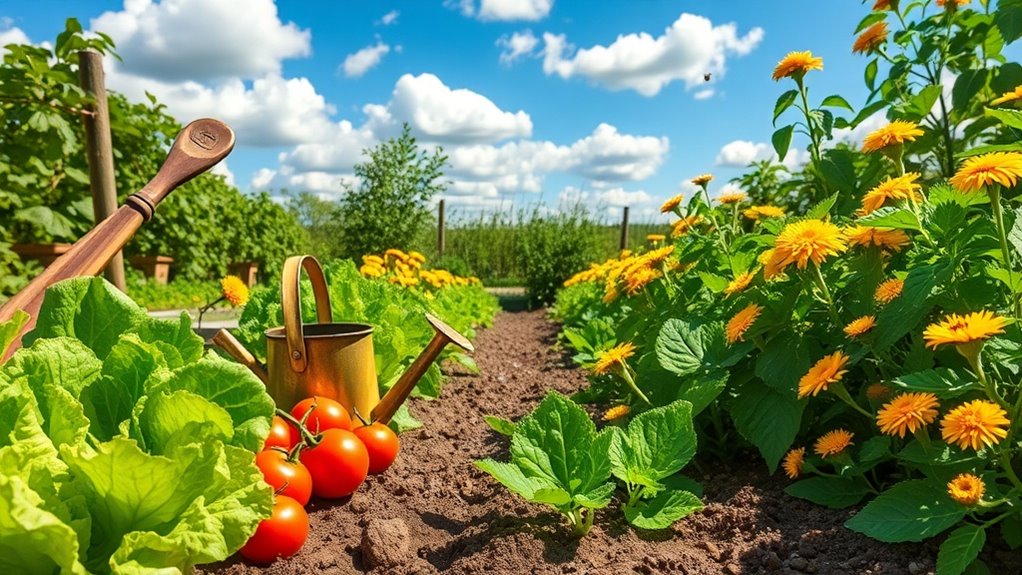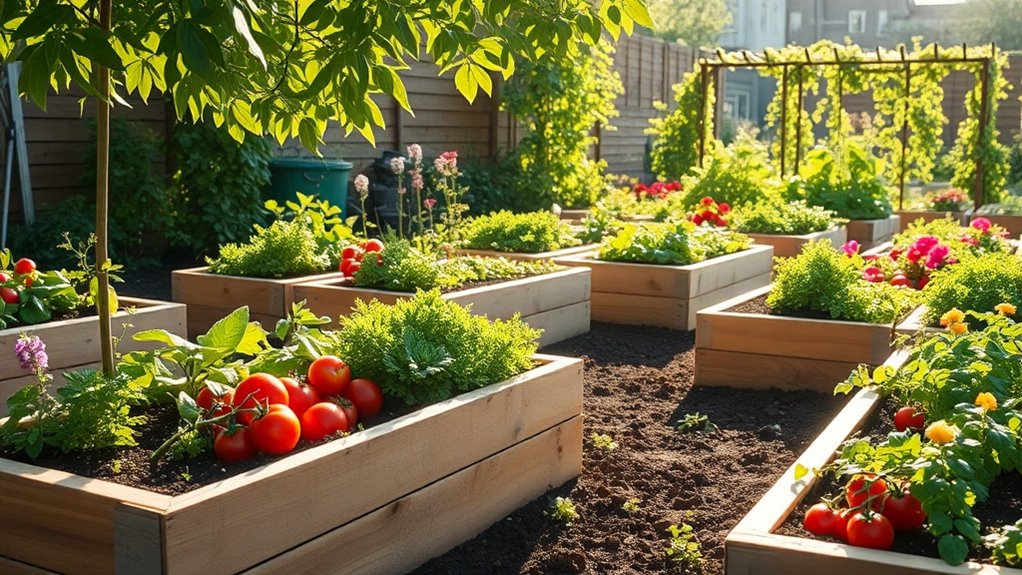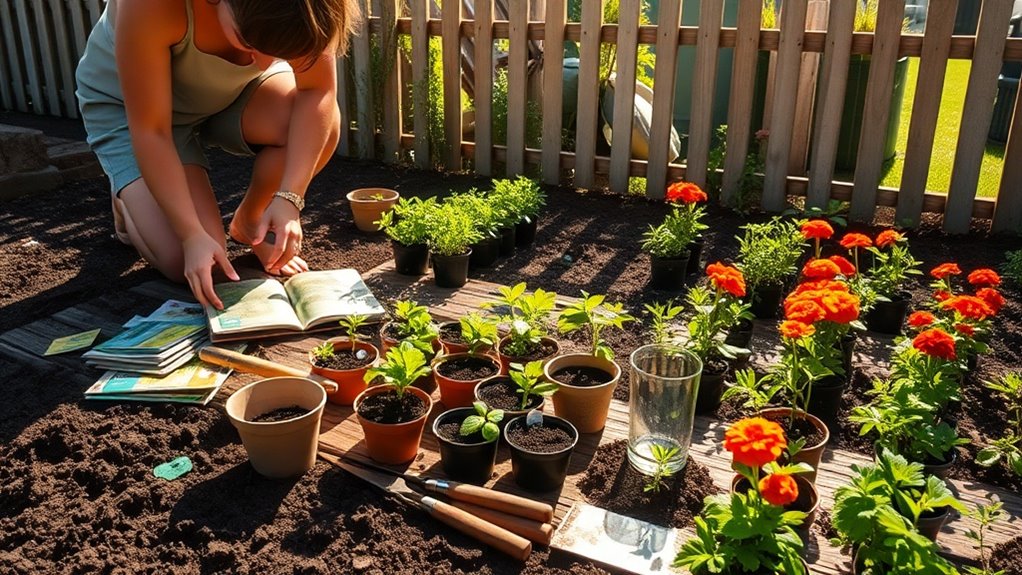The Beginner’s Secret to a Blooming Backyard Garden
You’ll unlock the secret to a blooming backyard garden by picking a sunny spot with good drainage and prepping your soil through testing and compost amendments. Choose hardy plants like mint or tomatoes, then plant them at the right depth with proper spacing for strong roots. Water deeply but infrequently, apply organic fertilizers every 4-6 weeks, and manage weeds and pests naturally with mulch and beneficial insects. Prune regularly to promote airflow and maximize yield through smart spacing. Follow these steps for even greater garden success.
Key Takeaways
- Choose a sunny spot with good drainage and enrich soil with compost for healthy plant foundations.
- Select easy-to-grow plants like herbs and tomatoes that match your local hardiness zone.
- Water deeply but infrequently, checking soil moisture to encourage strong root development.
- Apply organic fertilizers every 4-6 weeks and use natural methods to manage weeds and pests.
- Prune regularly and monitor plants weekly to boost airflow and maximize garden yields.
Choosing the Ideal Garden Spot
When you’re planning your backyard garden, choosing the ideal spot sets the foundation for success.
As a beginner, you start by evaluating sunlight—most plants need six to eight hours daily, so pick a spot that gets ample rays without shade interference.
Check for good drainage to avoid water pooling, which can harm roots.
Consider wind exposure and easy access for watering and weeding.
These beginner gardening tips help you select a practical location that maximizes growth and minimizes challenges, ensuring your first garden thrives efficiently.
To ensure optimal plant health, incorporate universal soil prep methods that adapt to various environmental conditions.
Additionally, remember to evaluate soil preparation as a key factor for supporting healthy plant growth.
Preparing Your Soil for Success
To prepare your soil for a thriving garden, start by testing its quality to assess nutrient levels and pH balance. Soil testing is crucial as it enhances plant health and helps prevent costly gardening mistakes.
Once you’ve got those results, amend the soil with compost to enrich it and enhance its texture.
Next, improve drainage by incorporating materials like sand or gravel, ensuring roots get the right moisture without excess water.
Additionally, explore backyard solutions to enhance your soil using natural, readily available materials from your own yard.
Test Soil Quality
Testing your soil’s quality is the first essential step in preparing a thriving backyard garden.
You’ll test for pH levels, which determine if your soil is acidic, neutral, or alkaline, directly impacting nutrient availability for plants.
Assess key nutrients like nitrogen, phosphorus, and potassium using affordable home test kits—just follow the instructions to collect and analyze samples.
For precise results, send soil to a local lab for detailed reports on texture and composition.
This practical approach helps you identify issues early, ensuring your garden starts strong without unnecessary complications.
Amend With Compost
Once you’ve tested your soil, you’ll amend it with compost to boost fertility and address any imbalances.
Compost, a blend of decomposed organic matter, adds vital nutrients like nitrogen and phosphorus while enhancing microbial activity for better root health.
Based on your soil test, incorporate 20-50% compost by volume; for sandy soils, it improves water retention, and for clay, it aids aeration.
Spread a 2-4 inch layer evenly, then till it into the top 6-12 inches using a fork or tiller.
Choose well-aged, weed-free compost to avoid issues, ensuring long-term soil vitality for thriving plants.
Monitor results seasonally.
Improve Soil Drainage
Although poor drainage can lead to waterlogged soil and root diseases, you’ll improve it by assessing your site’s conditions and applying practical fixes like adding coarse materials or creating raised beds.
First, test soil percolation by digging a hole and pouring in water; if it pools, amend with sand or gravel to enhance airflow. For clay-heavy soils, incorporate perlite or organic matter to break up compaction.
Build raised beds using untreated wood or bricks to elevate roots above poor-draining areas. Monitor regularly with a soil probe, adjusting as needed to prevent erosion and promote healthy growth.
Selecting Beginner-Friendly Plants
When you dive into gardening, picking beginner-friendly plants sets you up for success by focusing on hardy varieties that thrive with minimal care.
To select wisely, evaluate your space’s conditions first, like sunlight exposure and soil quality. Begin with easy-to-grow herbs like mint or leafy greens that resist bolting.
Popular choices include tomatoes and basil, which are forgiving and productive. For beginners, effortless gardening plants such as the three easy-to-care-for options can bring joy with their low maintenance requirements.
Flowers such as marigolds and petunias offer bright colors with little fuss.
Ensure plants suit your USDA hardiness zone to prevent damage. This approach minimizes failures and maximizes your gardening joy.
By incorporating these selections, you can also explore the care requirements that make these plants ideal for beginners, ensuring even easier management.
Essential Planting Techniques
To grow a successful garden, you prepare the soil by testing its pH and amending it with compost for optimal nutrient levels. After preparing the soil, it’s essential to plan your garden layout for efficient use of space and resources.
Then, you place seeds at the right depth and spacing to promote strong germination and prevent overcrowding.
Mastering these techniques helps you establish a healthy foundation for your plants.
Additionally, performing soil testing is crucial for identifying and addressing potential issues that could hinder your garden’s success.
Soil Preparation
Before you plant, proper soil preparation sets the stage for a thriving garden by ensuring nutrients and drainage support your plants’ needs.
First, test your soil’s pH and composition with a simple kit to identify deficiencies. If it’s too acidic, add lime; for alkalinity, mix in sulfur.
Enrich it by incorporating compost or organic matter, which boosts fertility and retains moisture without waterlogging.
Loosen compacted soil with a garden fork to promote root growth and aeration.
You’ll avoid common pitfalls like poor yields by tailoring your soil’s texture and nutrient levels precisely for success.
Seed Placement
Once you’ve prepared your soil, proper seed placement becomes key to maximizing germination and healthy growth.
Start by consulting seed packets for specific depth and spacing requirements, as these vary by plant type. For instance, plant small seeds like lettuce at 1/4 inch deep, while larger ones like beans go 1-2 inches down.
Space seeds to prevent overcrowding—aim for 2-6 inches apart based on the crop. Use a dibber or finger to create holes, place seeds carefully, and firm the soil around them for good contact.
Water gently to avoid erosion, then label rows for easy tracking. This technique ensures even emergence and robust plants, setting your garden up for success.
Watering Strategies for New Gardens
As you establish a new garden, effective watering strategies become crucial for promoting strong root systems and preventing plant stress. During periods of extreme heat, additional measures like those for scorching weather can help maintain plant hydration.
You’ll want to water deeply but infrequently, allowing soil to dry slightly between sessions—this encourages roots to grow downward. Check moisture by inserting your finger two inches into the soil; if it’s dry, it’s time to water.
Use a soaker hose or drip irrigation to target roots directly, minimizing evaporation. Water early in the morning to reduce fungal risks, and aim for about an inch per week, adjusting for weather.
Monitor plants for wilting or yellowing leaves as indicators.
To avoid hindering your garden’s progress, be aware of common mistakes like overwatering that can lead to unhealthy plants.
Fertilizing to Promote Healthy Growth
With your watering routine established, you can enhance plant vitality by fertilizing correctly.
Select a balanced N-P-K fertilizer after testing your soil’s nutrient levels. For beginners, opt for organic types like compost or fish emulsion, as they’re gentle and improve soil structure.
Apply it every 4-6 weeks during the growing season, using half the recommended dose initially to prevent root burn. Mix granular fertilizers into the topsoil and water thoroughly afterward.
Monitor plant responses; yellow leaves might signal nitrogen deficiency, prompting adjustments. Always store fertilizers safely and wear gloves for handling.
This practice boosts blooms and yields effectively. Additionally, to further enrich your soil, consider incorporating organic composting with kitchen scraps and garden waste. Moreover, by utilizing kitchen scraps in your composting efforts, you can create nutrient-rich soil enhancers that promote sustainable gardening.
Managing Weeds and Pests Naturally
While your garden flourishes from regular fertilizing, you’ll need to tackle weeds and pests using natural methods to maintain a healthy ecosystem.
These approaches protect beneficial insects and soil health without chemicals.
-
Mulch beds: Apply organic mulch like straw to suppress weeds, retaining moisture and moderating soil temperature.
-
Hand-pull weeds: Remove weeds early by pulling them out, preventing seed spread and reducing competition for nutrients.
-
Introduce predators: Release ladybugs or nematodes to control aphids and other pests, creating a balanced ecosystem.
-
Use natural sprays****: Apply diluted neem oil or soap solutions to deter insects, ensuring you test on a small area first.
Routine Care and Pruning Tips
Routine care and pruning keep your garden plants healthy and productive.
You’ll need to water deeply but infrequently, ensuring soil stays moist without waterlogging. Check plants weekly for signs of stress or disease, and apply organic mulch to retain moisture and suppress weeds.
For pruning, use sharp, clean shears to remove dead or crossing branches, promoting air flow and new growth. Prune flowering plants after blooming and shrubs in late winter.
Monitor growth patterns; thin crowded areas to prevent fungal issues. Always wear gloves to protect your hands during these tasks.
Stay consistent for thriving results.
Maximizing Your Garden’s Yield
Once you’ve handled routine care and pruning, focus on boosting your garden’s yield through targeted techniques.
These methods help you produce more from your space efficiently.
-
Optimize spacing: Plant crops at recommended distances to reduce competition for nutrients and sunlight, promoting healthier growth.
-
Enhance soil fertility: Test soil pH and amend with organic compost or balanced fertilizers to supply essential nutrients.
-
Implement efficient watering: Use drip irrigation to deliver precise moisture, minimizing waste and preventing root diseases.
-
Monitor and control pests: Regularly inspect plants and apply integrated pest management strategies to protect yields without chemicals.





